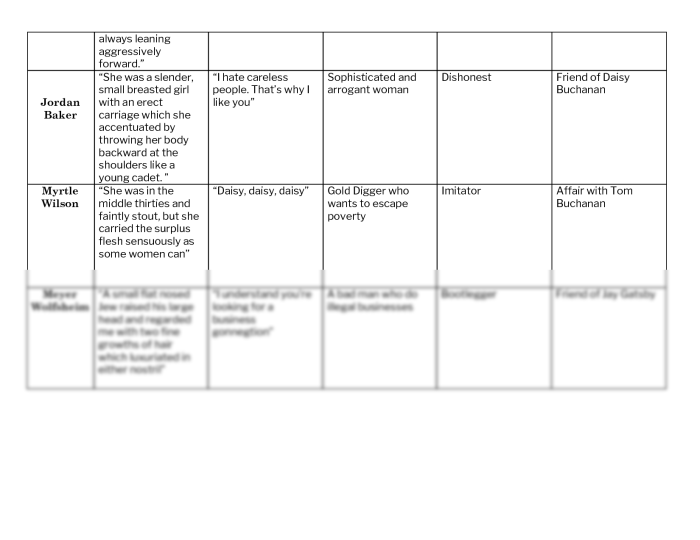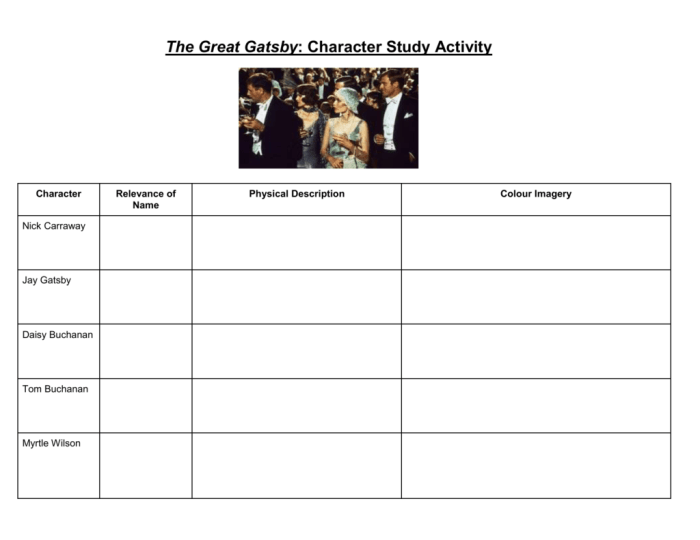The Great Gatsby Character Worksheet delves into the intricate tapestry of characters woven by F. Scott Fitzgerald in his iconic novel. This comprehensive resource provides a structured approach to analyzing the motivations, relationships, and transformations of the characters, offering a deeper understanding of their significance within the narrative.
Through detailed character studies, exploration of relationships and dynamics, and examination of symbolism and imagery, this worksheet guides learners in unraveling the complexities of Gatsby, Daisy, Nick, and the supporting cast. It fosters critical thinking, analytical skills, and an appreciation for the literary artistry of Fitzgerald’s masterpiece.
Character Analysis

The characters in “The Great Gatsby” are complex and multifaceted, each playing a significant role in the novel’s exploration of the American Dream.
Jay Gatsby
Jay Gatsby is the enigmatic protagonist of the novel, a self-made millionaire who throws lavish parties in an attempt to win back the love of his life, Daisy Buchanan.
Daisy Buchanan
Daisy Buchanan is a beautiful and wealthy woman who is torn between her love for Gatsby and her desire for stability and social status.
Nick Carraway
Nick Carraway is the narrator of the novel, a young man from the Midwest who moves to New York and becomes Gatsby’s neighbor.
Relationships and Dynamics
The relationships between the characters in “The Great Gatsby” are complex and often fraught with conflict.
The Romantic Relationship between Gatsby and Daisy
Gatsby and Daisy’s relationship is the central focus of the novel. They were once deeply in love, but their relationship was cut short by Gatsby’s poverty.
Friendships and Alliances
Nick Carraway forms friendships with Gatsby and Jordan Baker, a professional golfer. These friendships provide Nick with insights into the characters and their motivations.
Social Hierarchy and Class Dynamics
The novel explores the social hierarchy and class dynamics of the Roaring Twenties. Gatsby, a self-made millionaire, is seen as an outsider by the wealthy elite.
Symbolism and Imagery

“The Great Gatsby” is rich in symbolism and imagery, which F. Scott Fitzgerald uses to convey themes and emotions.
The Green Light
The green light at the end of Daisy’s dock symbolizes Gatsby’s hope for the future and his belief that he can win Daisy back.
Colors and Imagery
Fitzgerald uses colors and imagery to create a vivid and evocative atmosphere. The Valley of Ashes, a desolate industrial wasteland, represents the moral decay of the Roaring Twenties.
The Valley of Ashes
The Valley of Ashes symbolizes the moral decay and social inequality of the Roaring Twenties.
Themes and Literary Devices

“The Great Gatsby” explores a variety of themes, including the American Dream, love, and loss.
The American Dream
The American Dream is a central theme in the novel. Gatsby believes that anyone can achieve success through hard work and determination.
Foreshadowing, Irony, and Other Literary Devices, The great gatsby character worksheet
Fitzgerald uses a variety of literary devices, including foreshadowing, irony, and symbolism, to create a rich and complex narrative.
Setting and Time Period
The novel is set in the Roaring Twenties, a time of economic prosperity and social change. The setting plays a significant role in shaping the characters and their actions.
Character Development and Transformation
The characters in “The Great Gatsby” undergo significant development and transformation throughout the novel.
Gatsby’s Character Development
Gatsby’s character development is central to the novel. He begins as a mysterious and enigmatic figure, but gradually reveals his true self to Nick.
The Impact of Events on the Characters’ Lives and Choices
The events of the novel have a profound impact on the characters’ lives and choices. Gatsby’s death, in particular, forces the characters to confront their own mortality and the meaning of life.
The Role of Regret and Nostalgia in Shaping the Characters’ Actions
Regret and nostalgia play a significant role in shaping the characters’ actions. Gatsby is haunted by his past mistakes, while Nick is nostalgic for the past and the innocence of his youth.
Historical and Cultural Context: The Great Gatsby Character Worksheet
“The Great Gatsby” is a product of its time and place, reflecting the social and cultural changes of the Roaring Twenties.
Historical Context
The novel is set against the backdrop of the Roaring Twenties, a time of economic prosperity and social change.
Influence of the Jazz Age
The Jazz Age, a period of cultural and artistic innovation, had a significant influence on the novel’s characters and setting.
Social and Cultural Commentary
Fitzgerald uses the novel to explore the social and cultural changes of the Roaring Twenties, including the rise of consumerism and the decline of traditional values.
Top FAQs
What is the significance of the green light in The Great Gatsby?
The green light symbolizes Gatsby’s unattainable dream of recapturing the past and winning Daisy’s love.
How does Nick Carraway’s role as narrator impact the story?
Nick’s perspective as an outsider and participant provides a unique and nuanced lens through which readers experience the events and characters of the novel.
What are the major themes explored in The Great Gatsby?
The novel explores themes such as the American Dream, the pursuit of wealth and status, the complexities of love and relationships, and the corrosive effects of the past.
